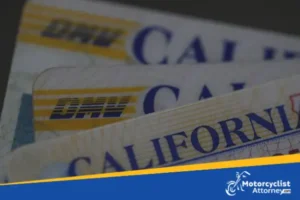
Motorcycle riders should place a premium on road safety.
According to the Insurance Information Institute (III), motorcycle riders were approximately 29 times more likely than passenger car occupants to die in an incident in 2019. Additionally, the Insurance Institute for Highway Safety (IIHS) and the Highway Loss Data Institute (HLDI) revealed that the number of motorcycle fatalities in California in 2019 had climbed somewhat, with 474 fatalities reported that year.
These motorcycle accident deaths accounted for 13% of the 3,606 total motor vehicle deaths in the state that year. For these alarming reasons, it is imperative that motorcycle riders are aware of safety measures to take every time they hit the road and especially while riding a motorcycle in the rain and wet roads.
Common Causes of Motorcycle Accidents
One of the most common causes of motorcycle accidents is bad weather. It is advisable to avoid riding a motorcycle in unfriendly conditions, regardless of your degree of skill, because rain presents a variety of hazards for motorcyclists. When the skies are clear, you may trust your skills and ability to control the vehicle, but you might not be prepared to ride in terrible weather.
However, there may be times, especially in California, when you are trapped in the rain or need to ride in the rain to get from point A to point B. In this case, you should follow these motorcycle safety tips when riding a motorcycle through the rain to avoid injury.
8 Motorcycle Safety Tips When Riding In Poor Weather Conditions
Is riding a motorcycle in the rain bad? Based on our extensive experience in riding motorcycles in rain accidents, we at Motorcyclist Attorney have compiled 8 motorcycle safety tips to help you have a safer and more enjoyable ride through the rain. Contact us to book a free consultation to discuss your legal options if you have been injured in a motorcycle accident in California.
1. Reduce your speed.
Keep in mind that in the rain, rider traction is greatly reduced regardless of the condition of the motorcycle’s tires. Any type of moisture effectively brings all of the oil to the pavement’s surface, making it nearly as slick as ice.
That is why the best thing to do while riding a motorcycle in rain is to go at a slower speed. Reducing speed makes it easier to come to a sudden stop if there’s a hazard in your path. It also reduces your lean angle on turns, making it less likely that your motorcycle will slip out from under you.
2. Know your route.
Before you hit the road, check on the weather condition of the route you are about to take. Avoid routes that may be prone to rain if at all possible. Set up some alternate routes in case the rain turns into a downpour, so you have some safe ways out of the slippery conditions. Include routes with rest stops or businesses that provide shelter just in case visibility or traction becomes a problem in wet weather.
3. Check before riding.
Before riding in challenging conditions, especially in the rain, make sure your motorcycle is in tip-top shape. This, of course, includes tires and brakes, but it is a good idea to inspect your bike on a regular basis to ensure that everything is in working order.
When it comes to motorcycle tires, tread depth is important because it allows your tires to channel water. Check tire pressure to ensure that your wheels are not over or under-inflated. You can also check for leaks in your bike’s oil and brake fluid. If your motorcycle leaks oil or brake fluid and it mixes with water on the road, it can make the road surface slippery and cause you to lose control of the vehicle.
Your brake pads should be checked regularly as well. Finally, inspect your brakes to ensure that they are in good working order just in case you need to stop abruptly while riding a motorcycle in bad weather.
4. Have the proper gear.
One of, if not the most important, injury-preventing actions that bike motorists may take while riding a motorcycle in the rain is to wear proper riding gear. Windproof, breathable, and waterproof gear is ideal for jackets, pants, and other garments. The majority of rain gear fabrics that have all three of these characteristics are also durable, lightweight, and tear-resistant.
The following will complete your motorcycle gear:
- Helmet: The best protection against water is a full-faced helmet. An anti-fog visor, a breath guard, or a visor with an electric defrost function should all be included. Riders who wear a partial face mask should have rain goggles with them.
- Waterproof riding boots: Choose waterproof boots to prevent water from infiltrating your clothing.
- Waterproof gloves: Wear waterproof gloves that fit snugly to prevent water from penetrating the rest of your outfit.
5. Be on the lookout for obstacles.
When you are riding a motorcycle in rainy weather, you have to be aware of possible obstacles — both blatant and hidden. Allow for more braking distance and pay extra attention to the road. Any type of paint or uneven pavement is extremely dangerous. Keep an eye out for any potholes or manhole covers, which might be covered with water in heavy rain.
6. Maintain a safe distance.
It’s always a good idea to leave enough space between yourself and the vehicle in front of you to react if they suddenly swerve or slam on their brakes. This rule becomes even more important when the slick road makes it difficult to come to a complete stop without sliding. Pay attention to the traffic in front of you and to the sides of you so that you can find an escape route quickly if an accident occurs ahead of you.
7. Always be ready.
Weather can change at any time, that is why you must always have your rain riding gear with you at all times. You can keep this in your motorcycle’s storage compartment or safely strap it to your bike. It is also wise to have with you a small, water-resistant box to store valuables such as wallets, phones, and important documents. Always be ready for adverse riding conditions so you will know what to do just in case you will get caught in a downpour while riding a motorcycle.
8. Stop.
If traction and visibility are compromised while riding to the point where you feel unsafe, pull over to a safe location and wait for the inclement weather to stop. Safe riding rules dictate that if heavy fog or rain begins to fall, you must automatically consider pulling over. Trust your instincts. It’s never worth putting yourself in a dangerous position just to get to your destination faster.
In An Accident? Motorcyclist Attorney Will Fight For You
Riding a motorcycle in the rain differs from riding in sunny circumstances. Rain alters the road surface and your visibility, so you must adjust your riding technique, be mindful of road surface conditions, and keep an eye out for how fast you are going.
However, even if you take all necessary safety precautions, you may still end up in a motorcycle accident despite your best efforts to avoid one. If your accident was caused by the negligence of another person, a skilled motorcycle accident attorney in California can assist you.
When you book an appointment with Motorcyclist Attorney, we can explore your legal alternatives if we conclude that you have a viable claim for compensation against a negligent motorist.
Remember, you DO NOT owe us any legal fees unless we successfully recover compensation on your claim if you decide to pursue your case with us. Our attorneys work on a contingency fee basis, which means that you only pay us if we help you recover compensation.Call 844-284-9437 for your free consultation. We speak English and Spanish.




